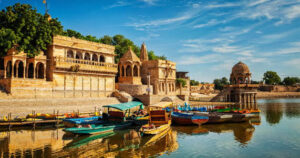Rajasthan, often associated with its desert landscapes, palatial architecture, and rich cultural heritage, also boasts a diverse range of wildlife sanctuaries and national parks. These areas are home to an array of flora and fauna, offering unique wildlife experiences through safaris and nature trails. This guide explores some of the best places in Rajasthan for wildlife enthusiasts to discover the region’s rich biodiversity.
1. Ranthambhore National Park
Ranthambhore National Park is one of the most renowned wildlife reserves in India, located in the Sawai Madhopur district of Rajasthan. Spanning over 1,334 square kilometers, it is one of the prime examples of Project Tiger’s conservation efforts.
Tiger Safaris: The park is famous for its population of Bengal tigers, making it a prime location for tiger safaris. The best time to visit is from October to June, when tigers can often be spotted around water bodies.
Flora and Fauna: Besides tigers, the park is home to various other species such as leopards, hyenas, sloth bears, and over 300 species of birds. The park’s landscape includes deciduous forests, grasslands, and lakes, providing a rich habitat for its wildlife.
Historical Sites: The Ranthambhore Fort, a UNESCO World Heritage Site, is located within the park. Exploring this ancient fort adds a historical dimension to the wildlife experience.
2. Sariska Tiger Reserve
Situated in the Alwar district, Sariska Tiger Reserve covers an area of 866 square kilometers. It is another important sanctuary under Project Tiger, with a diverse ecosystem supporting a variety of wildlife.
Wildlife Safaris: The reserve offers both jeep and canter safaris, providing opportunities to spot tigers, leopards, and various deer species such as sambar and chital. Bird watchers can also enjoy sightings of numerous bird species.
Historical Monuments: Within the reserve, visitors can explore the ruins of ancient temples and the Kankwari Fort, adding a cultural element to their visit.
Conservation Efforts: Sariska is notable for its tiger relocation project, which has successfully reintroduced tigers into the reserve after they were poached to extinction in the early 2000s.
3. Keoladeo National Park
Formerly known as Bharatpur Bird Sanctuary, Keoladeo National Park is a UNESCO World Heritage Site located in Bharatpur. This park is famous for its avian population, particularly during the winter months.
Bird Watching: The park is a haven for bird watchers, hosting over 370 species of birds. It is especially known for its migratory birds, including the rare Siberian crane, which visits during the winter.
Diverse Ecosystem: The park’s wetlands, woodlands, and grasslands provide a diverse habitat that supports a wide variety of flora and fauna, including mammals like wild boars, nilgai, and porcupines.
Cycling and Walking Trails: Unlike other parks where safaris are the norm, Keoladeo offers the unique experience of exploring its terrain on foot or by bicycle, making it a more intimate and eco-friendly way to enjoy the wildlife.
4. Desert National Park
Located near Jaisalmer, the Desert National Park is a unique sanctuary that showcases the Thar Desert’s ecosystem. Covering an area of 3,162 square kilometers, it is one of the largest national parks in India.
Desert Wildlife: The park is home to a variety of desert wildlife, including the endangered Great Indian Bustard, which is one of the heaviest flying birds. Other species include the desert fox, chinkara, and various reptiles.
Sand Dunes and Fossils: The park’s landscape features vast sand dunes, rocky surfaces, and salt lake bottoms. It is also known for its fossil reserves, with some fossils dating back 180 million years.
Safari Experiences: Jeep safaris provide an exciting way to explore the park’s rugged terrain and spot its unique wildlife. The best time to visit is between November and January, when the weather is cooler.
5. Jhalana Leopard Safari Park
Located on the outskirts of Jaipur, Jhalana Leopard Safari Park offers a unique opportunity to spot leopards in their natural habitat. The park covers an area of 20 square kilometers and is known for its high leopard population density.
Leopard Safaris: Jhalana is famous for its leopard sightings, with chances of spotting these elusive cats being relatively high compared to other parks. The park also hosts a variety of other wildlife, including deer, blue bulls, and numerous bird species.
Accessibility: Being close to Jaipur, Jhalana is easily accessible and makes for a great addition to a Jaipur itinerary. The park offers both morning and evening safaris.
Flora and Fauna: Besides leopards, the park’s dry deciduous forests are home to various other wildlife species, providing a rich biodiversity in a relatively small area.
6. Kumbhalgarh Wildlife Sanctuary
Kumbhalgarh Wildlife Sanctuary surrounds the famous Kumbhalgarh Fort, a UNESCO World Heritage Site, and spans across the Aravalli range covering an area of 578 square kilometers.
Wildlife: The sanctuary is home to a variety of wildlife, including leopards, sloth bears, hyenas, and wolves. It also supports a significant population of birds, making it a good spot for bird watching.
Trekking and Safaris: Visitors can explore the sanctuary through jeep safaris and trekking routes. The trek from Kumbhalgarh to Ranakpur is particularly popular, offering stunning views of the Aravalli hills and the chance to spot wildlife along the way.
Flora: The sanctuary’s diverse flora includes several medicinal plants and trees, which add to the ecological significance of the area. The lush greenery contrasts beautifully with the arid surroundings of Rajasthan.
7. Mount Abu Wildlife Sanctuary
Mount Abu Wildlife Sanctuary, located in the only hill station of Rajasthan, covers an area of 288 square kilometers. The sanctuary is known for its rich biodiversity and scenic beauty.
Flora and Fauna: The sanctuary boasts a wide range of flora, including evergreen forests, and is home to various animals such as leopards, sloth bears, and sambars. It also hosts over 250 species of birds, making it a paradise for bird watchers.
Scenic Beauty: The sanctuary offers stunning views of the surrounding hills and valleys, with several viewpoints providing panoramic vistas. The cooler climate of Mount Abu makes it a pleasant retreat from the heat of the plains.
Trekking Trails: Numerous trekking trails wind through the sanctuary, allowing visitors to explore its diverse ecosystems on foot. The trails offer opportunities to spot wildlife and enjoy the natural beauty of the area.
8. Tal Chhapar Sanctuary
Located in the Churu district, Tal Chhapar Sanctuary is a lesser-known gem that offers a unique experience of the semi-arid grassland ecosystem. Covering an area of 7 square kilometers, it is relatively small but rich in biodiversity.
Blackbuck Sanctuary: The sanctuary is primarily known for its population of blackbucks, a graceful antelope species. Visitors can often see these animals grazing in the open grasslands, making for a picturesque sight.
Bird Watching: Tal Chhapar is also a haven for bird watchers, with over 300 species of birds recorded. It is particularly known for its raptors, including harriers, kestrels, and hawks, which migrate here during the winter months.
Unique Ecosystem: The sanctuary’s grassland ecosystem is home to various other species, including desert foxes, jungle cats, and a variety of reptiles. The open landscape and sparse vegetation provide a unique setting for wildlife observation.
9. Gajner Wildlife Sanctuary
Gajner Wildlife Sanctuary, located near Bikaner, is known for its scenic beauty and rich wildlife. The sanctuary is part of the larger Gajner Palace estate, which adds a touch of royal heritage to the natural surroundings.
Wildlife: The sanctuary is home to various species such as wild boars, antelopes, deer, and nilgai. The Gajner Lake within the sanctuary attracts a variety of bird species, making it a good spot for bird watching.
Royal Heritage: Visitors can combine their wildlife experience with a stay at the Gajner Palace, now a heritage hotel. The palace offers a glimpse into the royal lifestyle and provides luxurious accommodation amidst the natural beauty of the sanctuary.
Nature Trails: The sanctuary offers several nature trails and walking paths, allowing visitors to explore its diverse ecosystems on foot. These trails provide opportunities to spot wildlife and enjoy the serene surroundings.
10. Sitamata Wildlife Sanctuary
Sitamata Wildlife Sanctuary, located in the Pratapgarh district, covers an area of 423 square kilometers. The sanctuary is named after the goddess Sita and is known for its rich biodiversity and historical significance.
Flora and Fauna: The sanctuary’s dense forests are home to various species, including leopards, spotted deer, wild boars, and four-horned antelopes. It also supports a significant population of birds, making it a good spot for bird watching.
Historical Significance: The sanctuary is associated with the legend of Sita from the Ramayana, adding a cultural and historical dimension to the visit. The ancient Valmiki Ashram is located within the sanctuary and is a popular pilgrimage site.
Ecotourism: Sitamata offers several ecotourism initiatives, including guided nature walks and educational programs. These initiatives aim to promote conservation awareness and provide a sustainable way to explore the sanctuary’s natural beauty.
Conclusion
Rajasthan’s wildlife sanctuaries and national parks offer a diverse range of experiences for nature and wildlife enthusiasts.














